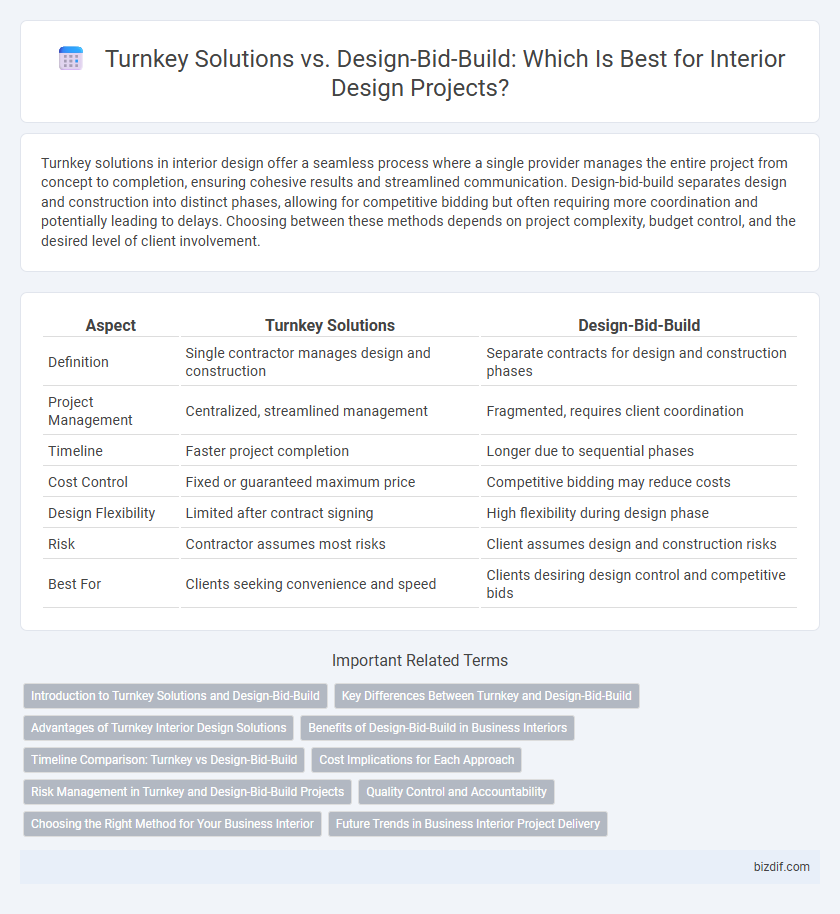Turnkey solutions in interior design offer a seamless process where a single provider manages the entire project from concept to completion, ensuring cohesive results and streamlined communication. Design-bid-build separates design and construction into distinct phases, allowing for competitive bidding but often requiring more coordination and potentially leading to delays. Choosing between these methods depends on project complexity, budget control, and the desired level of client involvement.
Table of Comparison
| Aspect | Turnkey Solutions | Design-Bid-Build |
|---|---|---|
| Definition | Single contractor manages design and construction | Separate contracts for design and construction phases |
| Project Management | Centralized, streamlined management | Fragmented, requires client coordination |
| Timeline | Faster project completion | Longer due to sequential phases |
| Cost Control | Fixed or guaranteed maximum price | Competitive bidding may reduce costs |
| Design Flexibility | Limited after contract signing | High flexibility during design phase |
| Risk | Contractor assumes most risks | Client assumes design and construction risks |
| Best For | Clients seeking convenience and speed | Clients desiring design control and competitive bids |
Introduction to Turnkey Solutions and Design-Bid-Build
Turnkey solutions in interior design offer a comprehensive approach where a single contractor manages the entire project from concept to completion, ensuring streamlined communication and consistent quality. In contrast, design-bid-build separates each phase, with designers creating plans, contractors bidding for the project, and construction executed by the selected bidder, often leading to longer timelines and potential coordination challenges. Choosing between these methods depends on project complexity, budget constraints, and desired control over design and construction processes.
Key Differences Between Turnkey and Design-Bid-Build
Turnkey solutions streamline the entire interior design process by offering a single contract for design, procurement, and construction, ensuring faster project completion and reduced client coordination. In contrast, Design-Bid-Build separates these phases, requiring clients to independently hire designers, then contractors through competitive bidding, often leading to longer timelines and potential miscommunication. The key difference lies in project management control, where turnkey shifts responsibility to one provider, while Design-Bid-Build maintains client oversight across distinct contracts.
Advantages of Turnkey Interior Design Solutions
Turnkey interior design solutions offer a streamlined process by providing a single point of contact responsible for both design and construction, reducing project timelines and minimizing communication errors. This integrated approach ensures consistent quality control and budget management, often leading to cost savings compared to the design-bid-build method. Clients benefit from expedited delivery and enhanced coordination, making turnkey solutions ideal for complex or time-sensitive interior design projects.
Benefits of Design-Bid-Build in Business Interiors
Design-bid-build offers businesses clear budget control and competitive pricing by separating design and construction phases, ensuring transparency and minimizing cost overruns. This traditional approach allows for specialized expertise during each phase, enhancing quality and adherence to client specifications in business interiors. Detailed contracts and bids provide accountability, reducing risks and fostering confidence throughout the project lifecycle.
Timeline Comparison: Turnkey vs Design-Bid-Build
Turnkey solutions streamline the project timeline by consolidating design and construction under a single contract, often reducing completion time by 30% compared to the Design-Bid-Build approach. Design-Bid-Build involves sequential phases--design, bidding, and construction--that can extend timelines due to separate contracts and potential delays in bidding or contractor selection. For interior design projects with tight deadlines, turnkey methods provide faster delivery through integrated scheduling and synchronized workflows.
Cost Implications for Each Approach
Turnkey solutions in interior design typically offer a fixed price that includes design, materials, and construction, reducing financial risks and unforeseen expenses. Design-bid-build often involves separate contracts for design and construction, which can lead to fluctuating costs due to competitive bidding and potential change orders. Choosing turnkey minimizes budget overruns, while design-bid-build may result in variable costs but allows more control over each project phase.
Risk Management in Turnkey and Design-Bid-Build Projects
Turnkey solutions streamline risk management by consolidating design, construction, and project delivery under a single contract, reducing liability exposure and minimizing coordination errors in interior design projects. In contrast, Design-Bid-Build separates these phases, increasing risks related to communication gaps, cost overruns, and schedule delays due to fragmented accountability. Effective risk mitigation in Design-Bid-Build demands rigorous contract management and stakeholder coordination to avoid costly disputes and ensure project alignment.
Quality Control and Accountability
Turnkey solutions in interior design offer centralized quality control and clear accountability as a single entity manages the entire project from concept to completion. In contrast, the design-bid-build approach involves multiple parties, which can complicate quality assurance and diffuse responsibility across designers, contractors, and subcontractors. This often leads to potential delays and conflicts that impact project consistency and accountability.
Choosing the Right Method for Your Business Interior
Turnkey solutions offer a streamlined approach by integrating design, construction, and project management into a single contract, reducing coordination efforts and accelerating project timelines for business interiors. Design-bid-build separates these phases, allowing for competitive bidding that can lower initial costs but may extend overall project duration and increase risk of miscommunication. Selecting the right method depends on your business's priorities for control, budget flexibility, and timeframe in delivering a customized interior environment.
Future Trends in Business Interior Project Delivery
Turnkey solutions streamline future business interior projects by integrating design, procurement, and construction into a single contract, reducing timelines and enhancing budget control. Design-bid-build remains prevalent for complex projects requiring specialized subcontractors, allowing competitive bidding but often leading to longer delivery phases. Emerging trends emphasize hybrid models incorporating digital collaboration platforms and sustainable materials to optimize efficiency and environmental impact in corporate interior design.
Turnkey solutions vs Design-bid-build Infographic

 bizdif.com
bizdif.com